Menus
- Classic on the outside, modern on the inside
- 100 hp, 112 Nm, 216 kg, new inverted fork and radial braking, from 13,300 €
- Discovery
- In the saddle
- In the city
- Motorway and expressways
- Departmental
- Comfort & duo
- Consumption
- Accessories
- Conclusion
Classic on the outside, modern on the inside
100 hp, 112 Nm, 216 kg, new inverted fork and radial braking, from 13,300 €
The Triumph staff are smiling right now. Sales are going well and we are promised “lots of good surprises” for next year. And when it comes to 2021 novelties, the English are not idle either. After the Speed Triple 1200 RS in April, the Hinckley firm invited us to Cascais in Portugal, to take charge of the new generation of the Speed Twin, gondola head (with the Thruxton) of its Classic range made up of no less than nine models. The initial pitch when Triumph developed the Speed Twin in 2019 was as follows: to offer a machine with the look of a Classic and the performance of a modern machine. And as is often the case at Hinckley, developments have been dictated by feedback from owners. Apparently, they want more performance since the objective for this 2021 vintage is to "reduce the gap between it and the Speed Triple" according to the video posted on their YouTube channel at the beginning of the year….
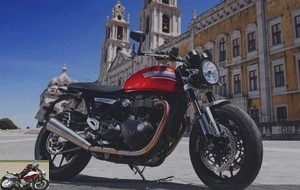 Triumph Speed Twin test
Triumph Speed Twin test
Discovery
…well, those who will be content to read the technical sheet diagonally will say that with three more little horses and a full weight increased by two kilos, there is nothing to recover from it at night. But that would be a big mistake, because the changes to the engine and chassis of the Speed Twin are much deeper than they appear..
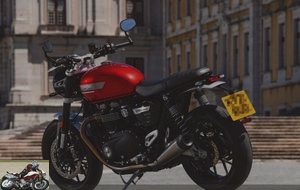 The Triumph Speed Twin version 2021
The Triumph Speed Twin version 2021
The transition to the Euro5 standard of this parallel twin 1200 cm3 set at 270 ° is accompanied by a host of modifications: new high compression pistons, redesigned exhaust ducts, new profiles of the camshafts, alternator and lighter crankshaft (inertia reduced by 17%) … The power goes from 97 to 100 hp and flows at 7,250 rpm, i.e. 500 rpm higher than before and the torque, unchanged (112 Nm) is available 500 rpm lower (4 250 rpm), ie an increase of the optimum range of use of 55%, excuse the little. The maintenance spacing remains unchanged with a first overhaul set at 16,000 km.
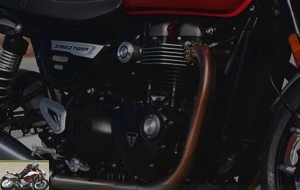 The twin wins 3 horses with its passage to Euro5
The twin wins 3 horses with its passage to Euro5
The chassis is not left out either. The traditional 41 mm fork is advantageously replaced by an inverted model with 43 mm cartridge and the braking has been copiously muscular; the double disc goes from 305 to 320 mm and the traditional Brembo calipers go by the wayside in favor of radial M50 models. For good measure, the geometry has been revised to promote a little more agility with a reduced wheelbase from 1430 to 1413 mm and a closed caster angle (22.3 ° instead of 22.8 °).
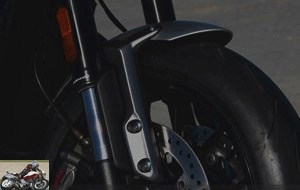 The gusseted fork gives way to an inverted Marzocchi fork
The gusseted fork gives way to an inverted Marzocchi fork
Ah and there are also new lightweight aluminum rims with a more airy design. Finally, note that if the size of the tires remains unchanged, the supply of the casings has been entrusted to another manufacturer: goodbye Pirelli Diablo Rosso III, they are now Metzeler Racetec RR. On the other hand, not a word in the press kit on the rear suspensions while the coils of the springs clearly look different between the two generations, weird…
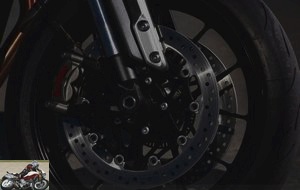 Braking is now provided by Brembo M50 calipers
Braking is now provided by Brembo M50 calipers
The weight is 216 kg all full facts against 214 kg on the first generation (manufacturer figures). Where does this additional weight come from despite the lightening of the crankshaft / alternator duo (and a few grams on the new rims)? Essentially, the inverted fork and the braking system. Now let’s move on to electronics: the three driving modes Rain, Road and Sport benefit from specific settings for traction control and injection mapping. You can change driving mode while driving – provided you disengage for a little more than a second – and the traction control can be disconnected by accessing (when stationary) the dashboard menu.
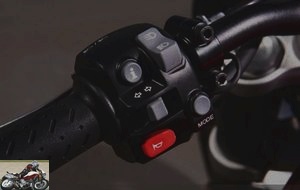 The commodos of the Triumph Speed Twin
The commodos of the Triumph Speed Twin
The new rims aren’t the only cosmetic touch-up. The matte black finish of the exhaust mufflers migrate to the cones (everything else is satin aluminum), the headlight support plates are different and some peripheral parts change from the “brushed aluminum” finish to black and vice versa.
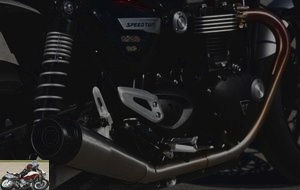 The silencer of the Triumph Speed Twin
The silencer of the Triumph Speed Twin
In the saddle
Triumph got a bit slashed by its fans when it moved part of its production to Thailand. Today, there are little more than English trade unionists to speak ill of models leaving Asian production lines (almost all of the range today). The finish of this Speed Twin is quite simply flawless: adjustments of the parts to the line, invisible wires, foundries, screws and paints more than premium. Even looking for the little beast I found nothing…
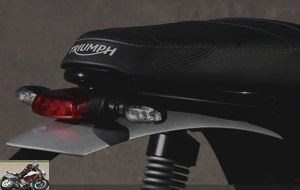 The headlight and the rear mudguard of the Triumph Speed Twin
The headlight and the rear mudguard of the Triumph Speed Twin
It’s time to step over the beautiful! The saddle is given for 809 mm in height against 807 mm previously without further explanation, but we always have both feet flat if we measure more than 169 cm. The driving position is moderately sporty with the bust barely tilted forward and the footrests set back slightly. The “breadboard” aspect of the saddle is deceptive; in reality the foam is thick, dense and ultimately very comfortable.
 The saddle of the Speed Twin rises to 809 mm
The saddle of the Speed Twin rises to 809 mm
The dashboard consists of two counters (tachometer and speedometer), each has a small liquid crystal screen displaying the usual suspects: gear engaged, odometer and two partial trips, fuel level, remaining range, traction control, average and instantaneous fuel consumption. On the left side, a button is used to choose the driving mode and a second to scroll through the information on the on-board computer. As on the previous vintage, a USB port is installed under the saddle. A pressure on the starter and the big twin immediately distills a serious and fat sound full of promises for the future..
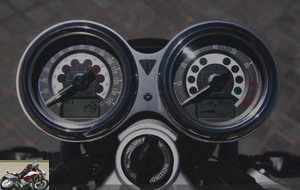 The double-dial speedometer of the Triumph Speed Twin
The double-dial speedometer of the Triumph Speed Twin
In the city
If the 216 kg are sensitive during maneuvers at a standstill, the Speed Twin seems much lighter as soon as you start driving and the grip is almost as obvious as on a Honda, absolute reference of the genre: ultra clutch soft, short deflections of the box, progressive profile of the new pneumatic assembly … The settings on the angle are done without the slightest effort and the slightly sagging side of the steering has completely disappeared here. In short, everything contributes to giving you confidence during low-speed evolutions..
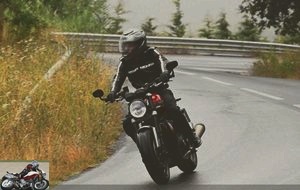 Road test of the Triumph Speed Twin
Road test of the Triumph Speed Twin
Well, almost everything. The turning radius, already pointed out on the first generation, still requires maneuvering during U-turns on narrow roads. I even suspect this 2021 version to be a bit worse off than the one it replaces since the diameter of the fork tubes has swelled by 2 mm.
Note also that the Triumph twin has slightly lost flexibility. At very low speed (idle does not drop lower than 1400 rpm once a gear is engaged against 1100 rpm previously), the lightened crankshaft lets some vibrations go up on the last three gears and the twin is not really up to speed. comfortable only from 2500 rpm. However, we can set off again in sixth on idle speed or roughly 60 km / h without taking off a seal. Sorry for my lack of precision, the display our test models displayed the speed in miles and km, but this last indication was printed as small as the conditions of exclusion of a life insurance…
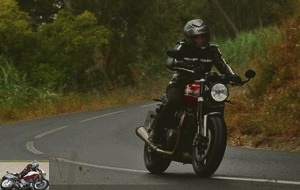 The Triumph Speed Twin in a curve
The Triumph Speed Twin in a curve
The mirrors at the end of the handlebars mirror well and the overall width of 778 mm (18 mm more than the 2019 version) has never been a handicap in interfiles.
Motorway and expressways
Our test course lacked a bit of variety and we only had the opportunity to cruiser 130 km / h once. For about 30 seconds. But the gear ratios haven’t changed so Damien’s remarks during his test in 2019 still hold true. No vibrations to report in the saddle, the handlebars or the footrests and the twin purrs at 4500 revolutions in sixth at 130 km / h or 250 revolutions above the maximum torque speed. Enough to ensure meteoric recovery in the event of an emergency overrun.
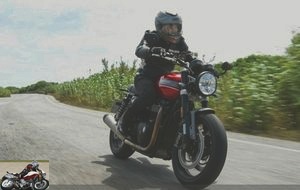 The Triumph Speed Twin on the road
The Triumph Speed Twin on the road
Departmental
The traction control and its personalized settings worked wonders on Portuguese roads. Enveloped in a permanent drizzle all morning, the Rain mode proved to be particularly gentle and effective in these dire conditions. His interventions are almost invisible while driving normally and remain very civilized when trying to provoke his intervention (like throttle fully in second on a pedestrian crossing). But even if the electronics take care of the grain, caution is still recommended, ultra sporty compounds do not like rain (no sculpture on the last few centimeters of the tread), nor low temperatures..
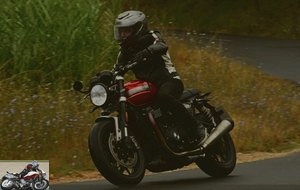 The Speed Twin also changed its tires to Metzeler Racetec RR
The Speed Twin also changed its tires to Metzeler Racetec RR
In the dry, my preference is for Sport mode, which is very responsive, never brutal and which allows you to take full advantage of engine modifications. Want to ride cool? It suffices to stay between 2,500 and 4,500 rpm to quietly wind on the torque and ensure muscular revivals. At these speeds, we take full advantage of the comfort of the suspensions and an instinctive and very homogeneous chassis. The feeling offered by the front axle is very reassuring and the Speed Twin turns on the angle of a single block. Imperturbable in big curves, it does not wriggle on bumps either, a sign that the front and rear suspensions are well tuned. So much the better, because apart from an adjustment of the preload at the rear, the settings are non-existent. To quibble, we would have liked a few millimeters more travel than the 120 mm available, the English roadster can be a bit too firm on big shocks.
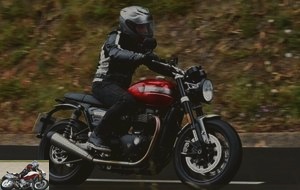 Torque of 112 Nm is now reached 700 rpm lower
Torque of 112 Nm is now reached 700 rpm lower
What if we force the pace? No problem, just stay above 4,500 rpm. The twin takes its turns with glee until the entrance to the red zone and remains keen on the changes of full throttle angles (thank you for the lightened crankshaft). The jerks of injection and the slight lack of rigor of the fork in muscular driving noted by Damien during his test of the first Speed Twin are only a distant memory. The chassis of this version 2.0 retains all its homogeneity in sporty driving and the new radial calipers, irreproachable in feeling and in power, respond present in all circumstances..
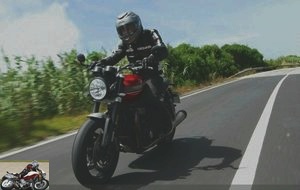 The maximum speed of the twin has been increased by 500 rpm
The maximum speed of the twin has been increased by 500 rpm
To go fast, however, it is recommended to adopt an academic riding style while always keeping a little brake when entering a turn. Because in case of excess optimism, grasping the brakes too brutally on the angle stiffens the whole and sometimes even goes so far as to raise the whole. This phenomenon is reduced if we use the rear brake, but piloting in “knife between teeth” mode remains the prerogative of the Triple. As for the soundtrack, no need for an adaptable exhaust to take full advantage of the twin’s sublime vocalizations: it sings when accelerating, it flatters when you cut the gas and the sound level is perfectly balanced. If someone reads me at Triumph, don’t change anything, it’s perfect !
Comfort & duo
Not much to report here. The saddle is very comfortable and allows great freedom of movement. Unless you ride with the crotch suctioned to the tank since the front of the saddle is very narrow to facilitate accessibility for small riders. For the passenger it is a little less rosy. Certainly, the footrests are not anchored too high, but there is only a strap to hang on and no grab handle as an accessory unlike the Bonneville. The sandbag could possibly be hooked to the tubes of the frame just below the saddle, but it is neither very ergonomic, nor very practical..
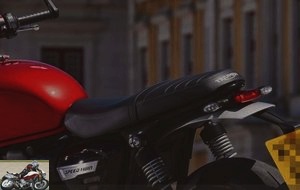 The two-seater seat of the Triumph Speed Twin
The two-seater seat of the Triumph Speed Twin
Consumption
The average consumption displayed on the dashboard after 400 km of driving (200 km for me and 200 km for the tester who preceded me on my machine) was 6 l / 100 km. Given our test conditions – a lot of stopping-acceleration during the photoshoots, rather high test pace, a lot of traffic jams – daily consumption should equal or barely exceed the normalized consumption announced for 5.1 liters . Combined with the 14.5 liters of the tank, this gives us a range of between 240 and 280 kilometers.
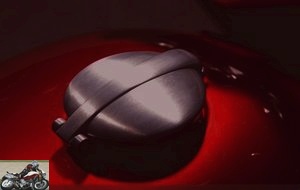 The tank is still adorned with its Monza cap
The tank is still adorned with its Monza cap
Accessories
I’m not going to give you a summary of the catalog. Just note that Triumph has rationalized its offer after two years of marketing, reducing from 80 to 50 the number of references available to customize its machine. Among the bestsellers, we can cite the accessories in die-cut aluminum, heated grips, a tire pressure monitor, several adaptable saddles, a little luggage and mini-indicators incorporating brake lights at the rear..
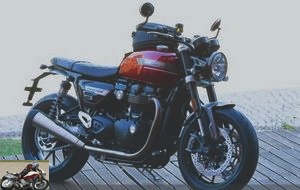 Accessorized Triumph Speed Twin
Accessorized Triumph Speed Twin
Conclusion
For our dear “fly trend zoophiles” readers (of which I am one), I will first list all the small details that annoy without deserving to appear in the list of weak points starting with the absence of hinge on the real plastic tank cap, the side stand lug too well hidden under the footrest and occasional heat rises when the radiator fan stashed just in front of the engine engages (but it rarely lasts more than one minute). There is also the obligation to engage in order to change driving mode – this is the rule at Triumph, only the Speed Triple escapes this constraint – and finally general ergonomics and suspension settings more suited to small riders. My colleagues of 6 feet and more as well as those weighing more than 80 kg – often the same ones – complained of having the legs a tad too bent and found the rear handsets too dry for their taste on the big shocks. On the “real” side, the list is shorter. The turning radius, already mentioned above, makes maneuvering tedious in tight spaces … And if the dashboard is very pretty, the meters lack readability in direct sunlight, especially the small digital windows. And that’s about it for the negative.
For the rest, the 2021 vintage of the Speed Twin is improving in all areas, cementing its qualities and erasing a good part of its old faults. The chassis gains in sportiness and efficiency without compromising on comfort or versatility and the large twin has gained in character and pleasure.
 The Triumph Speed Twin
The Triumph Speed Twin
On the price side, the novelty (available in concession from August) appears at € 13,300 in its jet black version and € 13,500 in Mat Storm Gray and Red Hopper. The marginal price increase is justified in view of the equipment revised upwards (engine and electronics upgrade, inverted fork and radial braking) and its quality-price-finish-equipment ratio remains a most competitive in the segment.
Its direct rival, the BMW NineT Pure (13,500 €) has a more assertive engine character and its maintenance-free cardan shaft transmission will appeal to commuters and always drives them, but it is necessary to draw cheerfully from the option catalog to match its level. equipment. And the original finish is set back compared to the English. Among the Italians, the Scrambler 1100 Sport Plus is significantly more expensive (€ 15,590) and the Japanese only offer three or four cylinders: Kawasaki Z 900 RS (€ 12,499), Yamaha XSR 900 (price nc, model currently unavailable at catalog) and possibly the Honda CB 1000 R (13.099 €) and Suzuki Katana (13.699 €) if you like models more neo than retro.
Strong points
- Sophisticated aesthetics and flawless finish
- Engine character and general approval of the twin
- Engine / chassis homogeneity
- Impeccable braking
- Effectiveness of electronic aids
- Exacerbated sporting potential
Weak points
- Turning radius
- Dashboard
The 2021 Triumph Speed Twin (Euro 5) technical sheet
Test conditions
- Itinerary: winding roads with very variable quality surfaces. A slew of crossings of towns / villages, almost no expressways and no motorway at all.
- Weather forecast: permanent drizzle in the morning and sun in the afternoon
- Test carried out over 207 km
- Problem encountered: RAS
Test equipment
- Shoei GT-Air II helmet
- Spidi jacket
- uglybros pants
- helston gloves
- Vanucci shoes
Related articles
-
Triumph Street Triple 675 R motorcycle test
Pocket hooligan… Appeared in 2007, the little Speed quickly gained unanimity around its engine and chassis. With 2,538 units sold in France in 2010…
-
Triumph Street Triple 765 RS motorcycle test
The Moto2 roadster 3-cylinder engine, 765 cc, 123 HP, 79 Nm, 166 kg dry, € 11,900 Since its release in 2007, the Street Triple has been a real commercial…
-
Triumph Street Triple 675 motorcycle test
The roadster version of the sporty Triumph Daytona 675 After releasing a sporty ‘600’ based on its 3 cylinder, Triumph declines the Daytona 675 in…
-
Queen of Hearts Twin of 1200 cm3, 105 hp, 112 Nm, Brembo M50 calipers, Metzeler Racetec RR tires, 16,700 euros A historic sporting legend led by equally…
-
Pure roadster The English brand has already presented its many Modern Classic novelties to us with a now large and complete Bonneville family. The update…
-
Triumph Speed Triple RS test
British icon returns sharper than ever 3 cylinders in line, 1050 cm3, 150 hp at 10,500 rpm, 117 Nm at 7,150 rpm, 189 kilos dry, from € 15,850 Remember:…
-
Triumph 1050 Speed Triple test
Relevant update ! Faced with the overbidding of its rivals, the Triumph Speed Triple had to evolve to stay in the game. Re-examined in depth, it gains…
-
Honda NC 700 S motorcycle test
Crisis solution Honda revives the basic motorcycle with its NC 700 S: a floor price, practical aspects borrowed from the scooter and consumption at the…
-
Gentleman Badass Triumph reinvents its flagship model, the Bonneville, in two versions, 900 Street Twin and T120 cubing 1200 cm3, succeeding the T100….
-
Asphalt AND mud in fun mode The range of light trails was born in 1993 with the F 650 GS. Powered by a Rotax single cylinder, the small everyday BMW was…
Nice presentation but the author is he mounted on the 2012 motorcycle or has he tried a current model by copying the characteristics of the 2012 ?
Sorry but owner of a 2006 model, I could write the same thing !
I know your job is not easy and neither do I;)
Perhaps you should reread more carefully … then you could notice some novelties in the 2012 vintage.
However, the intro alone already informs you of the absence of revolution on this model..
Really, a proofreading is in order.
minimal plastic evolution, but welcome I think. the rear gains in modernity while becoming a little more sober. Not a big fan of the two-tone fairing on the other hand, but to see it in real life.
I am not sure that this is a "job" tester on the Den .
.
 .
.
Or they are not paid dearly
If a tester on Le Repaire, it’s a job and testers paid (by Le Repaire), and moreover better than on other motorcycle media on the internet.